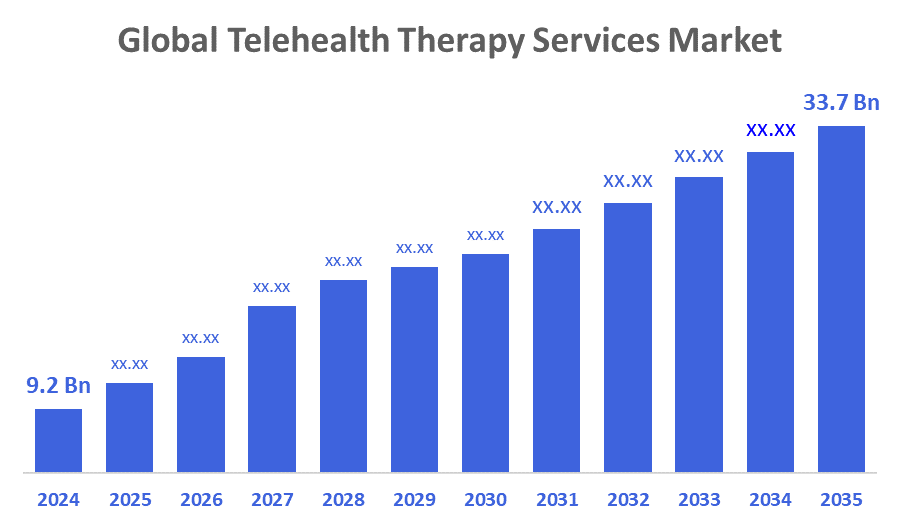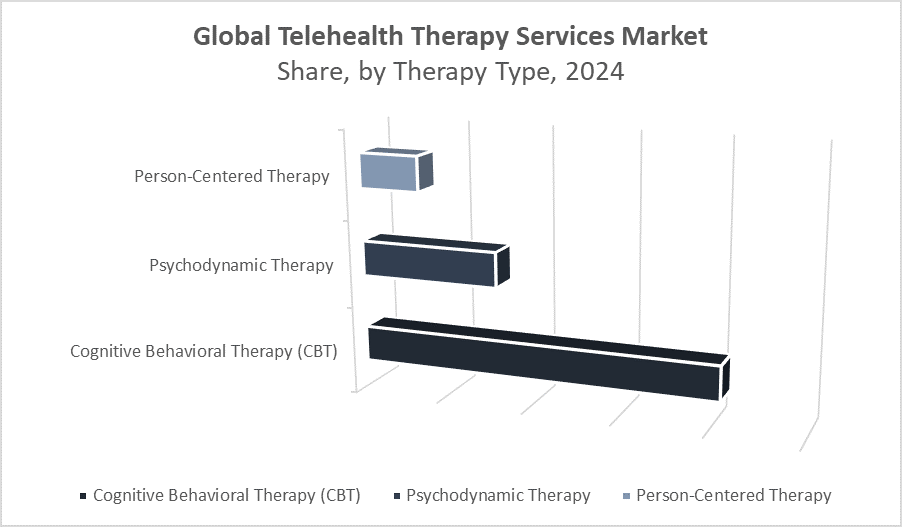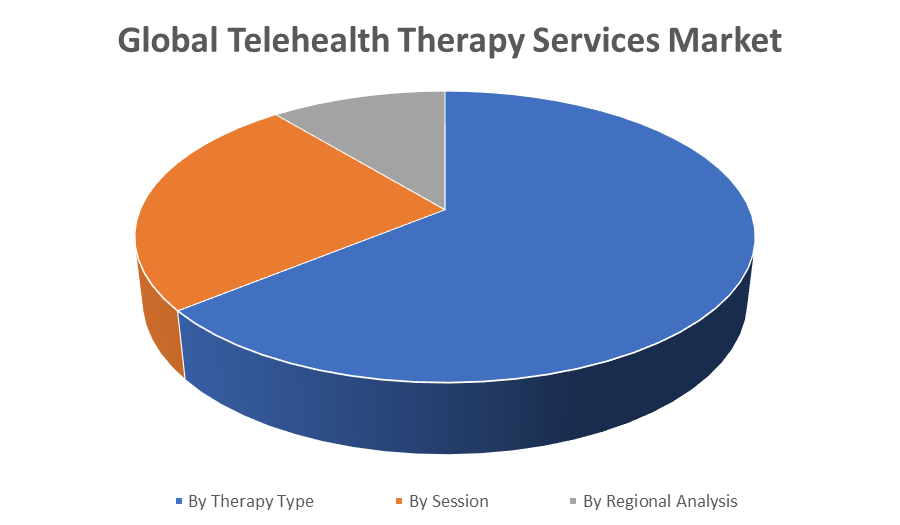Global Telehealth Therapy Services Market
Global Telehealth Therapy Services Market Size, Share, and COVID-19 Impact Analysis, Impact of Tariff and Trade War Analysis, By Therapy Type (Cognitive Behavioral Therapy (CBT), Psychodynamic Therapy, and Person-Centered Therapy), By Session (Video Conferencing, Instant Messaging / Chat, and Telephone (Audio)), and By Region (North America, Europe, Asia-Pacific, Latin America, Middle East, and Africa), Analysis and Forecast 2025 - 2035
Report Overview
Table of Contents
Telehealth Therapy Services Market Size Summary, Size & Emerging Trends
According to Decisions Advisors, The Global Telehealth Therapy Services Market Size is expected to Grow from USD 9.2 Billion in 2024 to USD 33.7 Billion by 2035, at a CAGR of 12.6% during the forecast period 2025-2035. Growing mental health awareness, convenience of virtual access, and ongoing digital transformation in healthcare are key factors driving market growth.

Key Market Insights
- North America dominated the market in 2024, holding the largest revenue share due to advanced digital health infrastructure and growing acceptance of remote therapy.
- Cognitive Behavioral Therapy (CBT) was the most utilized therapy type, favored for its structured approach and adaptability to virtual platforms.
- Video Conferencing emerged as the most preferred session format, offering real-time, face-to-face interaction between therapists and patients.
Global Market Forecast and Revenue Outlook
- 2024 Market Size: USD 9.2 Billion
- 2035 Projected Market Size: USD 33.7 Billion
- CAGR (2025-2035): 12.6%
- North America: Largest market in 2024
- Asia Pacific: Fastest growing market
Telehealth Therapy Services Market
The telehealth therapy services market focuses on the provision of psychological counseling and mental health therapy through digital communication platforms. These services range from cognitive behavioral therapy to psychodynamic and person-centered approaches, offered through video calls, chats, and phone sessions. Telehealth therapy addresses mental health needs with convenience, privacy, and reduced geographic limitations. Growing demand is fueled by increasing stress levels, anxiety disorders, and depression cases globally, coupled with rising internet penetration and smartphone usage. Favorable government policies and insurance coverage for virtual mental health services further enhance adoption across urban and rural populations.
Telehealth Therapy Services Market Trends
- Rising integration of AI-driven mental health tools for pre-screening and support
- Increased demand for culturally sensitive and multilingual therapy platforms
- Growth in subscription-based therapy models and app-based delivery
Telehealth Therapy Services Market Dynamics
Driving Factors: Growing mental health awareness and accessibility needs
Mental health awareness has surged globally, leading to reduced stigma and increased openness to therapy. Telehealth platforms offer convenience, privacy, and flexibility, making it easier for individuals to seek help without geographic or physical limitations. People in remote or underserved areas now access licensed therapists through secure video, chat, or phone sessions. The rising incidence of anxiety, depression, and stress-related disorders, especially post-pandemic, has significantly accelerated the adoption of online therapy. Additionally, busy lifestyles and long wait times for in-person appointments are prompting consumers to turn to virtual care as a timely and effective alternative.
Restrain Factors: Data privacy concerns and digital literacy gaps
Despite its benefits, telehealth therapy faces challenges in user trust and accessibility. Concerns about data privacy, cyber threats, and confidentiality make some users hesitant to fully engage in online therapy. The need for secure, HIPAA-compliant platforms adds operational costs for providers. Furthermore, older adults and individuals in developing regions may lack the digital skills or devices needed to use teletherapy effectively. Poor internet connectivity in rural areas also affects the user experience. These barriers slow the adoption rate, particularly in regions with limited digital infrastructure or populations unfamiliar with online communication technologies.
Opportunity: Expansion into underserved and rural areas
Telehealth therapy services present a major opportunity to expand access in rural and underserved communities, where mental health professionals are scarce. By utilizing mobile devices and internet connectivity, providers can deliver structured therapy to people who would otherwise remain untreated. Government initiatives supporting digital healthcare and public-private partnerships further encourage outreach. These efforts not only improve access but also reduce the burden on urban health facilities. Teletherapy can address language, cultural, and accessibility barriers with localized content and multilingual support, opening up new revenue streams and enabling providers to tap into previously unreachable patient populations.
Challenges: Limited insurance reimbursement in some markets
Although teletherapy has gained traction, inconsistent insurance coverage remains a major challenge. Some countries or insurers still do not reimburse online sessions at the same rate as in-person visits, making it harder for patients to afford long-term care. This disparity limits adoption, particularly in regions where out-of-pocket healthcare expenses are a concern. Moreover, cross-border licensing issues and evolving telehealth regulations create compliance hurdles for international service providers. These challenges hinder market expansion and deter smaller platforms from scaling. To drive growth, policy updates and standardized reimbursement models are essential across global healthcare systems.
Global Telehealth Therapy Services Market Ecosystem Analysis
The market ecosystem consists of licensed therapists, telehealth platforms, healthcare providers, insurance companies, and regulatory agencies. Seamless integration among these stakeholders ensures timely, secure, and effective service delivery. Platforms invest in HIPAA-compliant technologies, patient data encryption, and scalable infrastructure to meet growing demand. Continuous collaboration with mental health professionals, along with AI-supported backend analytics, improves engagement and therapeutic outcomes.
Global Telehealth Therapy Services Market, By Therapy Type
Cognitive behavioral therapy (CBT) dominated the telehealth therapy services market in 2024, accounting for approximately 48% of the total revenue share. Its structured, goal-oriented approach makes it well-suited for virtual delivery. CBT’s effectiveness in treating anxiety, depression, and stress-related disorders has made it the most widely adopted therapy type in digital mental health platforms. The short-term nature of CBT, along with its adaptability to video, chat, and app-based modules, supports widespread use in teletherapy. Increasing demand for evidence-based treatments and high acceptance among clinicians and patients contribute to CBT’s leading position in the market.

Psychodynamic therapy held around 28% of the global market share in 2024, reflecting growing interest in deeper, long-term approaches to mental health. This therapy type focuses on unconscious patterns, emotional conflict, and past experiences, offering patients a more introspective path to healing. While traditionally conducted in-person, advancements in secure video conferencing have enabled successful telehealth delivery. Patients seeking in-depth emotional support and long-term therapeutic relationships increasingly opt for psychodynamic therapy online. Its expanding presence on digital platforms highlights a shift toward personalized care models within the broader teletherapy landscape.
Global Telehealth Therapy Services Market, By Session
Video conferencing was the dominant session format in the telehealth therapy services market in 2024, accounting for approximately 60% of the total revenue share. Its popularity stems from the ability to replicate face-to-face interactions, allowing therapists to observe non-verbal cues, build rapport, and deliver more personalized care. Video sessions are widely preferred for therapies like CBT and psychodynamic approaches, where real-time communication enhances treatment outcomes. The growing availability of secure, HIPAA-compliant video platforms has also made it easier for providers to offer professional-grade therapy online.
Instant messaging and chat-based therapy sessions captured around 25% of the market share in 2024. This format appeals to users seeking discreet, flexible, and less confrontational ways to engage with therapists. It is particularly popular among younger demographics and those dealing with anxiety, who may find video sessions overwhelming. Asynchronous chat also allows patients to communicate at their own pace, making therapy more accessible for people with busy schedules or limited privacy at home.
North America led the global telehealth therapy services market in 2024, contributing approximately 42% of total revenue,
primarily due to well-established digital healthcare infrastructure, high-speed internet access, and widespread awareness about mental health. The United States and Canada have implemented favorable reimbursement frameworks, making virtual therapy financially viable for both providers and patients. Additionally, a tech-savvy population, early adoption of remote healthcare, and increasing mental health campaigns have significantly supported the integration of teletherapy into mainstream healthcare systems. A strong presence of leading telehealth platforms and licensed therapists further drives the region’s leadership position.
Asia Pacific is the fastest-growing region in the telehealth therapy services market, with a projected CAGR of 13.8% during the forecast period.
This rapid growth is fueled by increasing digital connectivity, smartphone adoption, and government-led digital health initiatives in emerging economies such as India, China, and Indonesia. Cultural shifts reducing stigma around mental health, along with the expansion of mobile health applications and localized teletherapy platforms, are enhancing accessibility. Countries like Japan and South Korea are also investing in AI-driven telehealth tools, accelerating adoption. The region’s vast, underserved rural populations present significant long-term growth opportunities.
Europe holds a substantial share of the market,
supported by government investments in mental healthcare, robust data privacy laws (e.g., GDPR), and increasing demand for multilingual and culturally sensitive therapy services. Countries like Germany, France, and the UK have well-regulated telehealth environments, which foster consumer trust. Growing awareness around work-related stress, aging populations, and post-pandemic mental health issues further drive demand for teletherapy. Additionally, the rise of cross-border telemedicine platforms and EU-level digital health integration efforts are expected to boost market penetration across the continent.
Latin America and the Middle East & Africa are experiencing steady growth in telehealth therapy services.
In Latin America, rising urban stress, growing middle-class internet usage, and mental health awareness campaigns in countries like Brazil, Argentina, and Mexico are encouraging adoption. In MEA, governments are beginning to partner with global telehealth providers to improve mental healthcare access in underserved communities. Despite infrastructure challenges, increasing mobile penetration, growing youth populations, and a shift toward digital-first health strategies are gradually enabling expansion across these emerging regions.
WORLDWIDE TOP KEY PLAYERS IN THE TELEHEALTH THERAPY SERVICES MARKET INCLUDE
- Talkspace
- BetterHelp
- MDLIVE
- Amwell
- Teladoc Health, Inc.
- 7 Cups
- Thriveworks
- Doctor on Demand
- MindBeacon
- Cerebral Inc.
- Others
Product Launches in Telehealth Therapy Services Market
- In March 2025, BetterHelp introduced an AI-assisted matching tool designed to improve how users are paired with licensed therapists. This innovative technology considers factors such as preferred language, therapist availability, and specific therapeutic approaches to ensure more personalized and effective therapy experiences. By tailoring matches more precisely, the platform aims to enhance patient satisfaction and treatment outcomes, making telehealth therapy more accessible and user-friendly.
- In January 2025, Teladoc Health broadened its virtual therapy services by launching multilingual Cognitive Behavioral Therapy (CBT) sessions. This expansion focuses on reaching diverse patient groups across North America and Europe, addressing language barriers and cultural differences. Offering therapy in multiple languages helps Teladoc cater to a wider audience and improve mental health support for non-English-speaking populations.
Market Segment
This study forecasts revenue at global, regional, and country levels from 2020 to 2035. Decisions Advisors has segmented the telehealth therapy services market based on the below-mentioned segments:

Global Telehealth Therapy Services Market, By Therapy Type
- Cognitive Behavioral Therapy (CBT)
- Psychodynamic Therapy
- Person-Centered Therapy
Global Telehealth Therapy Services Market, By Session
- Video Conferencing
- Instant Messaging / Chat
- Telephone (Audio)
Global Telehealth Therapy Services Market, By Regional Analysis
- North America
- US
- Canada
- Mexico
- Europe
- Germany
- UK
- France
- Italy
- Spain
- Russia
- Rest of Europe
- Asia Pacific
- China
- Japan
- India
- South Korea
- Australia
- Rest of Asia Pacific
- South America
- Brazil
- Argentina
- Rest of South America
- Middle East & Africa
- UAE
- Saudi Arabia
- Qatar
- South Africa
- Rest of the Middle East & Africa
Check Licence
Choose the plan that fits you best: Single User, Multi-User, or Enterprise solutions tailored for your needs.
We Have You Covered
- 24/7 Analyst Support
- Clients Across the Globe
- Tailored Insights
- Technology Tracking
- Competitive Intelligence
- Custom Research
- Syndicated Market Studies
- Market Overview
- Market Segmentation
- Growth Drivers
- Market Opportunities
- Regulatory Insights
- Innovation & Sustainability
Report Details
| Pages | 243 |
| Delivery | PDF & Excel via Email |
| Language | English |
| Release | Sep 2025 |
| Access | Download from this page |
